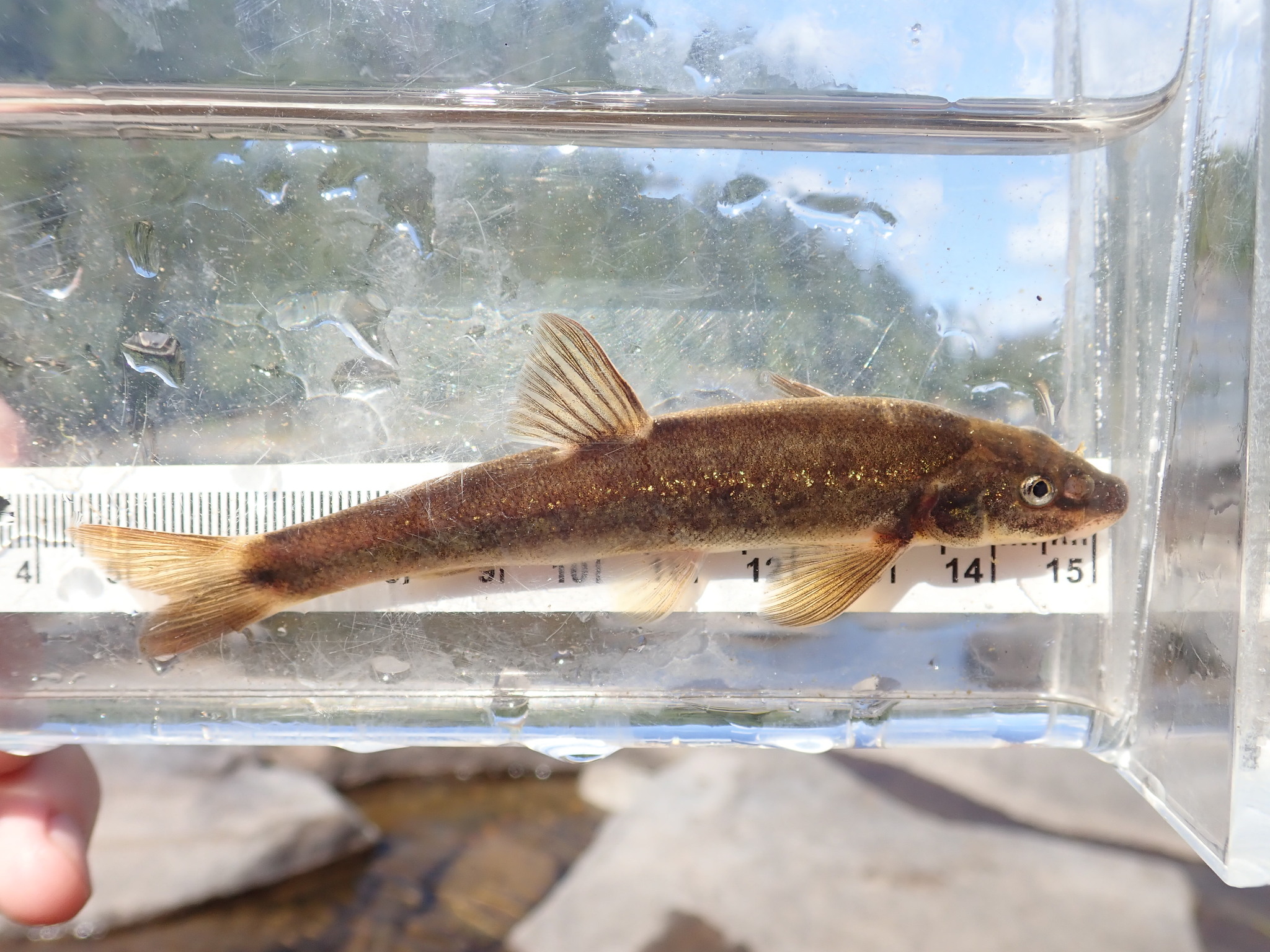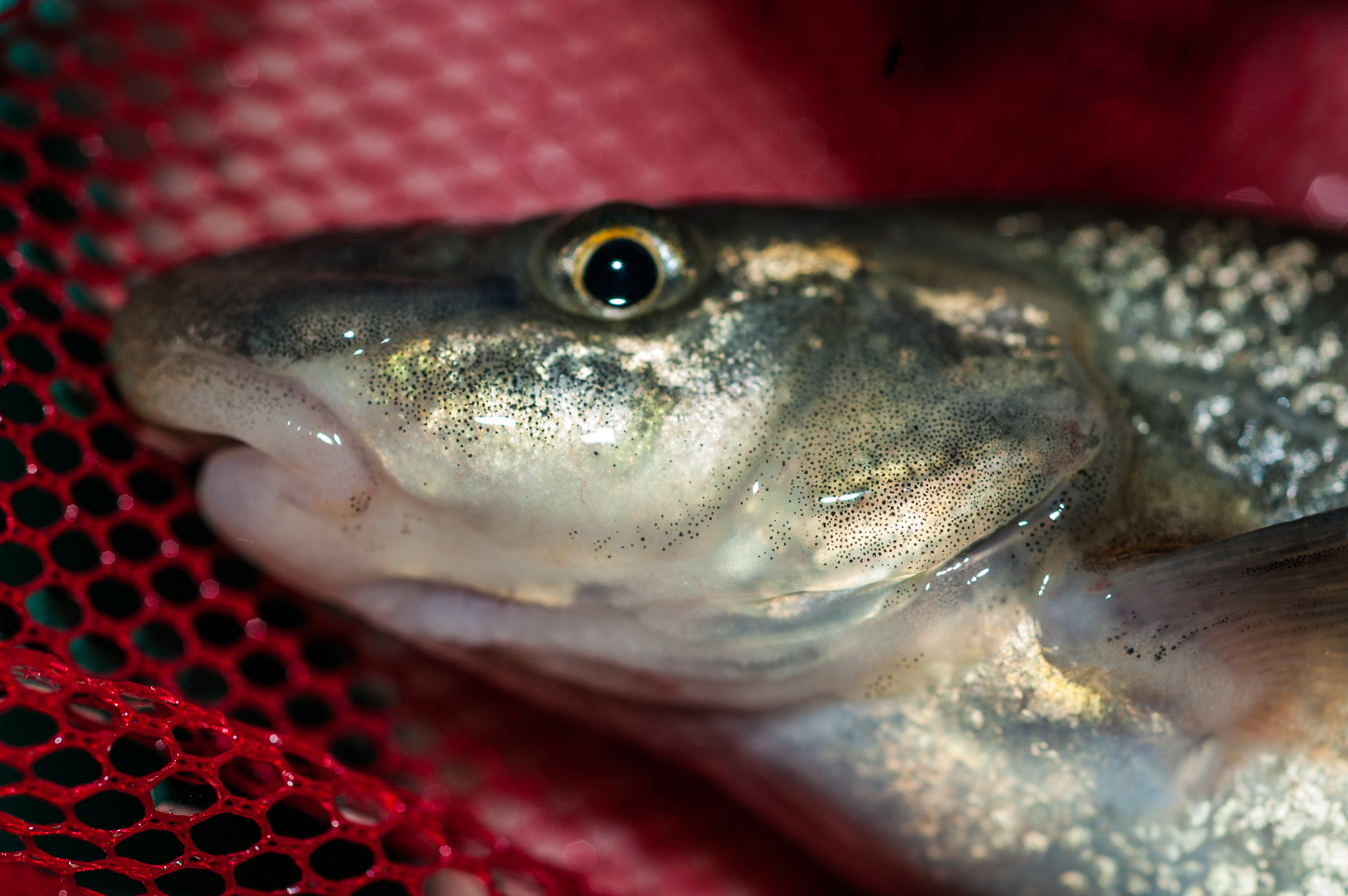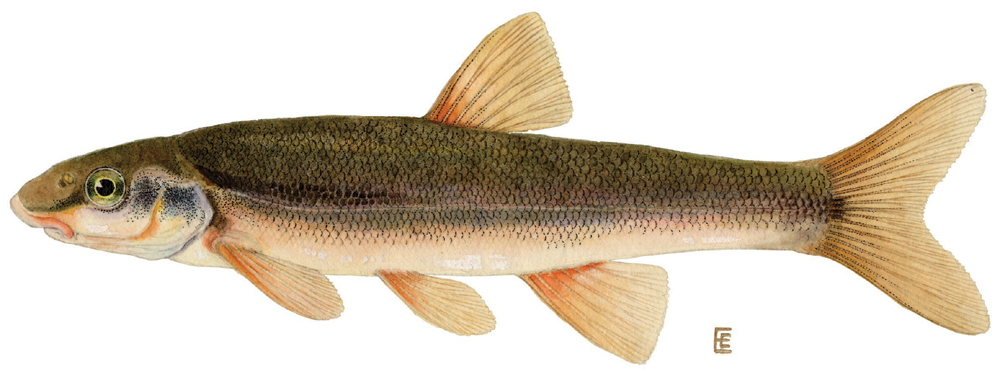Rhinichthys Cataractae on:
[Wikipedia]
[Google]
[Amazon]
 The longnose dace (''Rhinichthys cataractae'') is a freshwater minnow native to North America. ''Rhinicthys'' means snout fish (reference to the long snout) and ''cataractae'' means of the
The longnose dace (''Rhinichthys cataractae'') is a freshwater minnow native to North America. ''Rhinicthys'' means snout fish (reference to the long snout) and ''cataractae'' means of the
 Longnose dace occur in moderately cool water streams, rivers and lakes with temperatures up to . Longnose dace are
Longnose dace occur in moderately cool water streams, rivers and lakes with temperatures up to . Longnose dace are
"Habitat suitability index models: Longnose dace."
U.S. Department of the Interior, Fish and Wildlife Service. FWS/OBS-82/10.33 13 pp. Longnose dace are opportunistic foragers. Small longnose dace (≤ ) primarily consume algae and benthic invertebrates dace (> ) feed on fish scales, fish eggs, terrestrial insects, and aquatic benthic macroinvertebrates, although diet varies seasonally.Brazo, D.C., C.R. Liston and R.C. Anderson. 1978. "Life history of the Longnose dace, ''Rhinichthys cataractae'', in the surge zone of the eastern Lake Michigan near Ludington, Michigan". Transactions of the American Fisheries Society 107(4): 550–556.Thompson, A.R., J.T. Petty and G.D. Grossman. 2001. "Multi-scale effect of resource patchiness on foraging behavior and habitat use by longnose dace, ''Rhinichthys cataractae''". Freshwater Biology 46: 145–160. They are
Longnose dace are opportunistic foragers. Small longnose dace (≤ ) primarily consume algae and benthic invertebrates dace (> ) feed on fish scales, fish eggs, terrestrial insects, and aquatic benthic macroinvertebrates, although diet varies seasonally.Brazo, D.C., C.R. Liston and R.C. Anderson. 1978. "Life history of the Longnose dace, ''Rhinichthys cataractae'', in the surge zone of the eastern Lake Michigan near Ludington, Michigan". Transactions of the American Fisheries Society 107(4): 550–556.Thompson, A.R., J.T. Petty and G.D. Grossman. 2001. "Multi-scale effect of resource patchiness on foraging behavior and habitat use by longnose dace, ''Rhinichthys cataractae''". Freshwater Biology 46: 145–160. They are
 Longnose dace typically
Longnose dace typically
"Feminization of longnose dace (''Rhinichthys cataractae'') in the Oldman River, Alberta, (Canada) provides evidence of widespread endocrine disruption in an agricultural basin."
Scientifica 11 pages. Feminization is likely caused by estrogen-like compounds present in municipal wastewater effluent, agriculture, and cattle operations near the Oldman River, however this mechanism is not well understood. It is not known if increased vitellogenin expression and intersex gonads significantly decrease reproductive success and will impact the long term viability of longnose dace in these systems. There is not evidence of skewed sex ratios in the
 The longnose dace (''Rhinichthys cataractae'') is a freshwater minnow native to North America. ''Rhinicthys'' means snout fish (reference to the long snout) and ''cataractae'' means of the
The longnose dace (''Rhinichthys cataractae'') is a freshwater minnow native to North America. ''Rhinicthys'' means snout fish (reference to the long snout) and ''cataractae'' means of the cataract
A cataract is a cloudy area in the lens (anatomy), lens of the eye that leads to a visual impairment, decrease in vision of the eye. Cataracts often develop slowly and can affect one or both eyes. Symptoms may include faded colours, blurry or ...
(first taken from Niagara Falls
Niagara Falls is a group of three waterfalls at the southern end of Niagara Gorge, spanning the Canada–United States border, border between the Provinces and territories of Canada, province of Ontario in Canada and the state of New York (s ...
). Longnose dace are small, typically less than 100 mm and characterized by their fleshy snout that protrudes past the mouth. They are well adapted for living on the bottom of fast-flowing streams among stones. Longnose dace eat algae and aquatic insects and are important forage minnows for larger predatory fish.
Description
Longnose dace can be mistaken for suckers because of their subterminal "sucker-like" mouth. However, longnose dace (like all members of the familyCyprinidae
Cyprinidae is a family of freshwater fish commonly called the carp or minnow family, including the carps, the true minnows, and their relatives the barbs and barbels, among others. Cyprinidae is the largest and most diverse fish family, and t ...
) lack small fleshy projections, called papillae, on their mouths.
Juveniles have a black lateral line that extends from the beginning of the eye to the caudal fin
Fins are moving appendages protruding from the body of fish that interact with water to generate thrust and help the fish swim. Apart from the tail or caudal fin, fish fins have no direct connection with the back bone and are supported only ...
that fades as the fish matures. The lateral line in juveniles is not present in all populations. In adults, the dorsal side is dark green to black, the lateral side is darkish to silvery with mottling often present, and the ventral side is pearly.
Both adult males and females may have bright orange-reddish colouration at the base of pectoral, pelvic, and anal fins and on the upper lip. This colouration is typically associated with breeding males in the subspecies ''Rhinichthys cataractae cataractae'',Bartnik, V.G. 1971. "Comparison of the breeding habits of two subspecies of longnose dace, ''Rhinichthys cataractae''". Canadian Journal of Zoology 50: 83–86. but the validity of this subspecies has yet to be confirmed. Museum specimens of females also show intense orange-reddish colouration at the base of the fins and upper lip,Nelson, J.S. and M.J. Paetz. 1992. The Fishes of Alberta. The University of Alberta Press. Edmonton, Alberta. therefore colouration is not an accurate predictor of sex.
The maximum length of longnose dace is , but they are usually less than .
Geographic distribution
Longnose dace have the widest distribution of any cyprinid in North America, with a range reaching as far south as theRocky Mountains
The Rocky Mountains, also known as the Rockies, are a major mountain range and the largest mountain system in North America. The Rocky Mountains stretch in great-circle distance, straight-line distance from the northernmost part of Western Can ...
in northern New Mexico
New Mexico is a state in the Southwestern United States, Southwestern region of the United States. It is one of the Mountain States of the southern Rocky Mountains, sharing the Four Corners region with Utah, Colorado, and Arizona. It also ...
and as far north as the Mackenzie River near the Arctic CircleMcPhail, J.D. and C.C. Lindsay. 1970. Freshwater Fishes of Northwestern Canada and Alaska. Freshwater Research Board of Canada. Ottawa, Ontario. and across the continent from the Pacific to Atlantic coast. Multiple refugia during the most recent glacial maximum may explain the broad geographic distribution of longnose dace. There were up to three possible glacial refuges during Pleistocene
The Pleistocene ( ; referred to colloquially as the ''ice age, Ice Age'') is the geological epoch (geology), epoch that lasted from to 11,700 years ago, spanning the Earth's most recent period of repeated glaciations. Before a change was fin ...
glaciations: the Pacific, the Mississippi and the Atlantic. Longnose dace on the Quebec peninsula likely originated only from the Atlantic refuge, in contrast to other fish species on the peninsula that originated from multiple refugia.Girand, A. and B. Angers. "The impact of postglacial marine invasions on the genetic diversity of an obligate freshwater fish, the longnose dace (''Rhinichthys cataractae''), on the Quebec peninsula". Canadian Journal of Fisheries and Aquatic Sciences 63: 1429–1438. Longnose dace in northwestern North America originated from a Pacific refuge.McPhail, J.D. and E.B. Taylor. "Phylogeography of the longnose dace (''Rhinichthys cataractae'') species group in northwestern North America – the origin and evolution of the Umpqua and Millicoma dace". Canadian Journal of Zoology 87: 491–497.
Ecology
 Longnose dace occur in moderately cool water streams, rivers and lakes with temperatures up to . Longnose dace are
Longnose dace occur in moderately cool water streams, rivers and lakes with temperatures up to . Longnose dace are benthic
The benthic zone is the ecological region at the lowest level of a body of water such as an ocean, lake, or stream, including the sediment surface and some sub-surface layers. The name comes from the Ancient Greek word (), meaning "the depths". ...
and preferentially occupy rock and gravel substrate. During the day longnose dace hide under rocks. Longnose dace prefer shallow, fast-moving riffle
A riffle is a shallow landform in a flowing channel. Colloquially, it is a shallow place in a river where water flows quickly past rocks. However, in geology a riffle has specific characteristics.
Topographic, sedimentary and hydraulic indica ...
s in streams and rivers and the turbulent, near-shore region of lakes.Edwards, E.A., H. Li and C.B. Schreck. 1983."Habitat suitability index models: Longnose dace."
U.S. Department of the Interior, Fish and Wildlife Service. FWS/OBS-82/10.33 13 pp.
nocturnal
Nocturnality is a ethology, behavior in some non-human animals characterized by being active during the night and sleeping during the day. The common adjective is "nocturnal", versus diurnality, diurnal meaning the opposite.
Nocturnal creatur ...
feeders, possibly to avoid predation and/or salmonid competitors.Culp, J.C. 1978. "Nocturnally constrained foraging of a lotic minnow (''Rhinichthys cataractae'')". Canadian Journal of Zoology 67: 2008-2012.
Longnose dace have small home ranges and high site fidelity,Hill, J. and G.D. Grossman. 1987. "Home range estimates for three North American stream fishes". Copeia 1987(2): 376–380. however there is evidence that a small proportion are able to disperse distances greater than .Larson, G.L., R.L. Hoffman, and S.E. Moore. 2002. "Observations of the distribution of five fish species in a small Appalachian stream". Transactions of the American Fisheries Society 131(4): 791–796.
Life history
Longnose dace reach reproductive maturity at age two and have a mean lifespan of three years. Males and females have a maximum age of four and five, respectively. Longnose dace typically
Longnose dace typically spawn
Spawn or spawning may refer to:
* Spawning, the eggs and sperm of aquatic animals
Arts, entertainment and media
* Spawn (character), a fictional character in the comic series of the same name and in the associated franchise
** ''Spawn: Armageddon' ...
from May to August in water and some populations are multiple spawners.Roberts, J.H. and G.D. Grossman. 2001. "Reproductive characteristics of female longnose dace in the Coweeta Creek drainage, North Carolina, USA". Ecology of Freshwater Fish 10: 184–190 Time of spawning is dependent on water temperature. Longnose dace are polygynandrous
Polygynandry is a mating system in which both males and females have multiple mating partners during a breeding season. In sexually reproducing diploid animals, different mating strategies are employed by males and females, because the cost of gam ...
and males create and defend territories to attract females to enter and spawn. Males form a depression in the rocky substrate and vibrate to attract a female. When a female is receptive, she enters the territory and pushes her snout into substrate in a similar manner as the male. Both male and female tremble over the depression and release eggs and milt
Milt is the seminal fluid of fish, mollusks, and certain other water-dwelling animals. They reproduce by spraying this fluid which contains the sperm, onto roe (fish eggs). It can also refer to the sperm sacs or testes that contain the semen. ...
. Limited or no parental care is provided to young-of-the-year after hatching.
Anthropogenic disturbance
In southern Alberta longnose dace are exposed to organic, estrogen-like compounds.Jeffries, K.M., L.J. Jackson, M.G. Ikonomou, and H.R. Habibi. 2010. "Presence of natural and anthropogenic organic contaminants and potential fish health impacts along two river gradients in Alberta, Canada." Environmental Toxicology and Chemistry 29(10): 2379-2010. Downstream of wastewater effluent from the city ofRed Deer
The red deer (''Cervus elaphus'') is one of the largest deer species. A male red deer is called a stag or Hart (deer), hart, and a female is called a doe or hind. The red deer inhabits most of Europe, the Caucasus Mountains region, Anatolia, Ir ...
longnose dace are larger, increase in abundance, and have larger livers but males have reduced ability to produce testosterone
Testosterone is the primary male sex hormone and androgen in Male, males. In humans, testosterone plays a key role in the development of Male reproductive system, male reproductive tissues such as testicles and prostate, as well as promoting se ...
.Jeffries, K.M., L.J. Jackson, L.E. Peters and K.R. Munkittrick. 2008. "Changes in population, growth, and physiological indices of longnose dace (''Rhinichthys cataractae'') in the Red Deer River, Alberta, Canada." Archives of Environmental Contaminants and Toxicology 55: 639–65. Despite a morphologically healthy appearance, longnose dace in the Red Deer River are physiologically stressed. In the Oldman River
The Oldman River is a river in southern Alberta, Canada. It flows roughly west to east from the Rocky Mountains, through the communities of Fort Macleod, Lethbridge, and on to Grassy Lake, where it joins the Bow River to form the South Sa ...
, some longnose dace populations are characterized by elevated vitellogenin
Vitellogenin (VTG or less popularly known as VG) (from Latin ''vitellus'', yolk, and ''genero'', I produce) is a precursor of the egg yolk proteins. It is synthesized and secreted by the liver of vertebrates, fat body of insects and the hepatopa ...
expression, female biased sex ratios and intersex gonads.Jeffries, K.M., E.R. Nelson, L.J. Jackson and H.R. Habibi. "Basin-wide impacts of compounds with estrogen-like activity on longnose dace (''Rhinichthys cataractae'') in two prairie rivers of Alberta, Canada." Environmental Toxicology and Chemistry 27(10): 2042–2052.Evans, J.S., L.J. Jackson, H.R. Habibi, and M.G. Ikonomou. 2012."Feminization of longnose dace (''Rhinichthys cataractae'') in the Oldman River, Alberta, (Canada) provides evidence of widespread endocrine disruption in an agricultural basin."
Scientifica 11 pages. Feminization is likely caused by estrogen-like compounds present in municipal wastewater effluent, agriculture, and cattle operations near the Oldman River, however this mechanism is not well understood. It is not known if increased vitellogenin expression and intersex gonads significantly decrease reproductive success and will impact the long term viability of longnose dace in these systems. There is not evidence of skewed sex ratios in the
Bow River
The headwaters of the Bow River in Alberta, Canada, start at the Bow Glacier and Bow Lake (Alberta), Bow Lake in Banff National Park in the Canadian Rockies, Canadian Rocky Mountains. The glacial stream that feeds Bow Lake (Alberta), Bow Lake ...
.
References
{{Authority control Rhinichthys Fish of the Western United States Fauna of the Rocky Mountains Fish described in 1842 Freshwater fish of North America